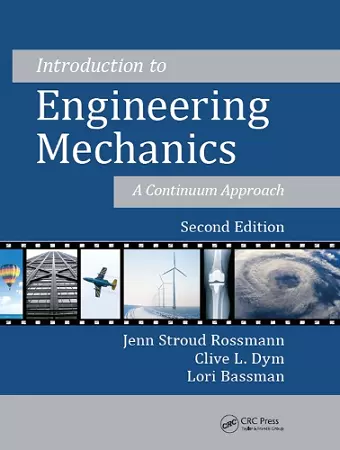Introduction to Engineering Mechanics
A Continuum Approach, Second Edition
Clive L Dym author Jenn Stroud Rossmann author Lori Bassman author
Format:Hardback
Publisher:Taylor & Francis Inc
Published:24th Mar '15
Currently unavailable, our supplier has not provided us a restock date

Integrated Mechanics Knowledge Essential for Any Engineer
Introduction to Engineering Mechanics: A Continuum Approach, Second Edition uses continuum mechanics to showcase the connections between engineering structure and design and between solids and fluids and helps readers learn how to predict the effects of forces, stresses, and strains. The authors’ "continuum checklist" provides a framework for a wide variety of problems in solid and fluid mechanics. The essence of continuum mechanics, the internal response of materials to external loading, is often obscured by the complex mathematics of its formulation. By gradually building the formulations from one-dimensional to two- and three-dimensional, the authors help students develop a physical intuition for solid and fluid behavior and for the very interesting behavior of those materials including many biomaterials, between these extremes. This text is an accessible first introduction to the mechanics of all engineering materials, and incorporates a wide range of case studies highlighting the relevance of the technical content in societal, historical, ethical, and global contexts. It also offers a useful perspective for engineers concerned with biomedical, civil, chemical, mechanical, or other applications.
New in the Second Edition:
The latest edition contains significantly more examples, problems, and case studies than the first edition.
The 22 chapters in this text:
- Define and present the template for the continuum approach
- Introduce strain and stress in one dimension, develop a constitutive law, and apply these concepts to the simple case of an axially loaded bar
- Extend the concepts to higher dimensions by introducing the Poisson’s ratio and strain and stress tensors
- Apply the continuum sense of solid mechanics to problems including torsion, pressure vessels, beams, and columns
- Make connections between solid and fluid mechanics, introducing properties of fluids and strain rate tensor
- Address fluid statics
- Consider applications in fluid mechanics
- Develop the governing equations in both control volume and differential forms
- Emphasize real-world design applications
Introduction to Engineering Mechanics: A Continuum Approach, Second Edition provides a thorough understanding of how materials respond to loading: how solids deform and incur stress and how fluids flow. It introduces the fundamentals of solid and fluid mechanics, illustrates the mathematical connections between these fields, and emphasizes their diverse real-life applications. The authors also provide historical context for the ideas they describe and offer hints for future use.
"This unique book by Rossmann, Dym, and Bassman provides an integrated foundation in solid and fluid mechanics that underpins a range of fields from bioengineering to water resources to aerospace design. Rather than being rooted in a particular engineering discipline (such as mechanical or civil), the book highlights the fundamental nature of continuum mechanics that makes it relevant to all engineers. With traditional disciplinary boundaries being crossed and new disciplines being created, this approach is just what is needed for today’s engineer."
—Andrew J. Guswa, Picker Engineering Program, Smith College, Northampton, Massachusetts, USA
"This book would be a good textbook for engineering mechanics and biomechanics courses. It provides a concise description of solid and fluid mechanics using a continuum perspective. The book is written by building gradually from one-dimensional to two- and three-dimensional formulations, and by including illustrative and interesting real-world case study examples. … a unified introduction to solid and fluid mechanics and the connection between them."
—Professor Long-yuan Li, University of Plymouth, UK
"… a very good mix of conceptual approaches and hands on examples. It covers concisely the most important topics without getting lost in too many specialty cases and examples. Compared to other classical books that spend most of the time on beam bending, this book covers the concepts of how forces act on matter in a generally applicable way which gives students a good feeling for what is going on inside the material rather than just how to use the formulas. The book also introduces some nice and very powerful techniques such as singularity functions that are often missing in other introductory books."
—Prof. Georg E. Fantner, École Polytechnique Fédéral de Lausanne
ISBN: 9781482219487
Dimensions: unknown
Weight: 1014g
462 pages
2nd edition